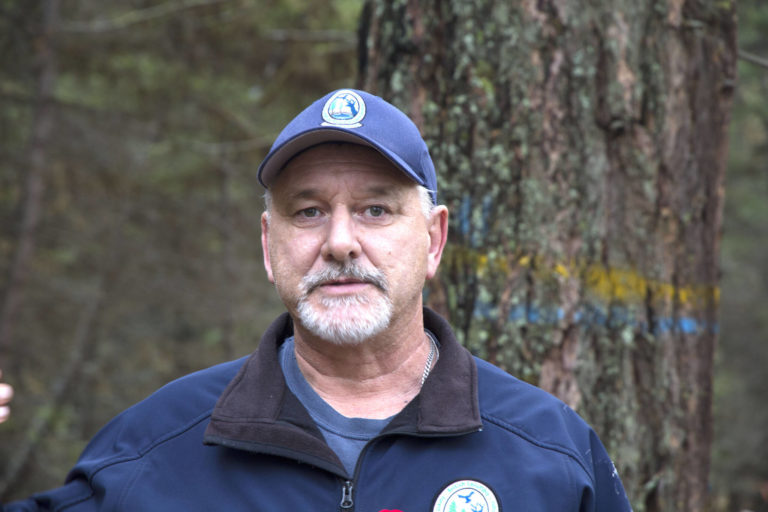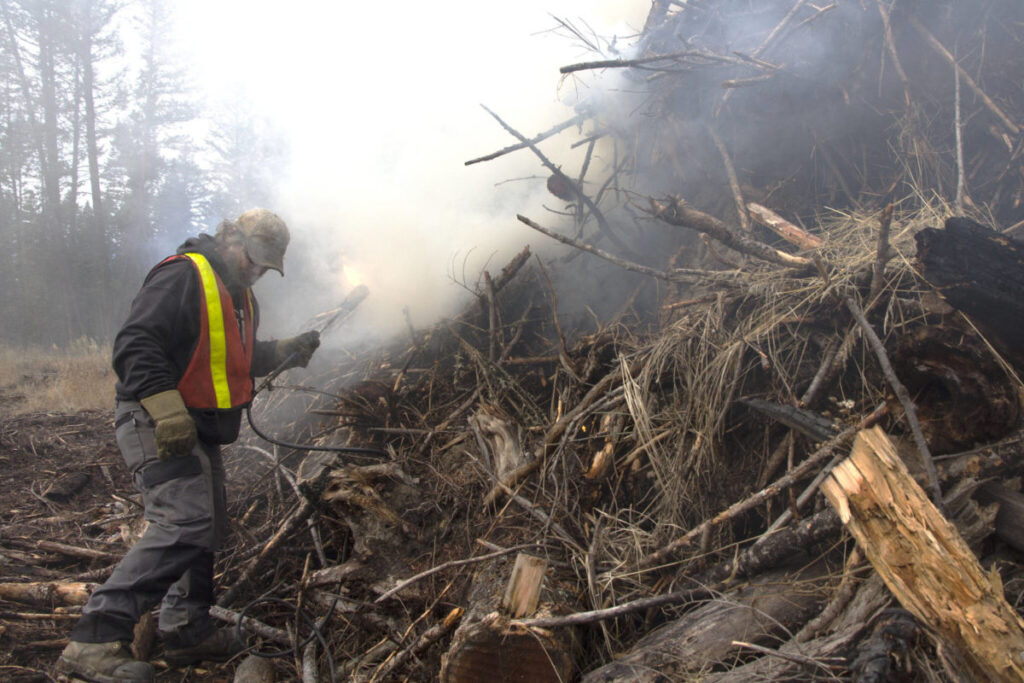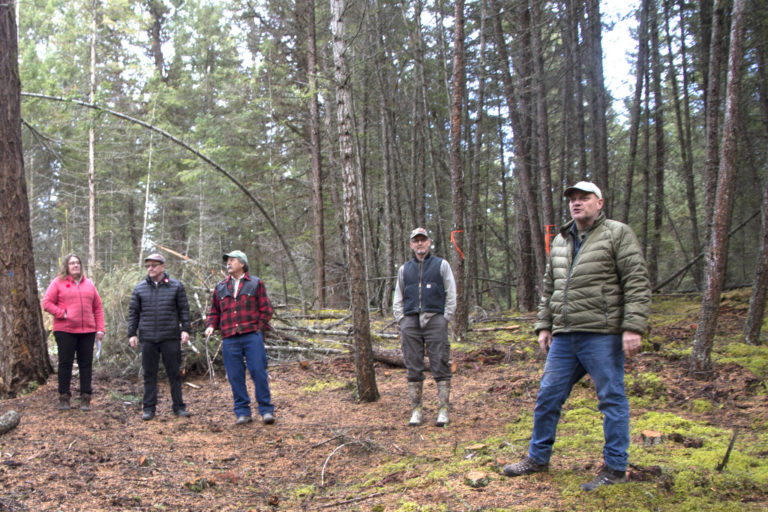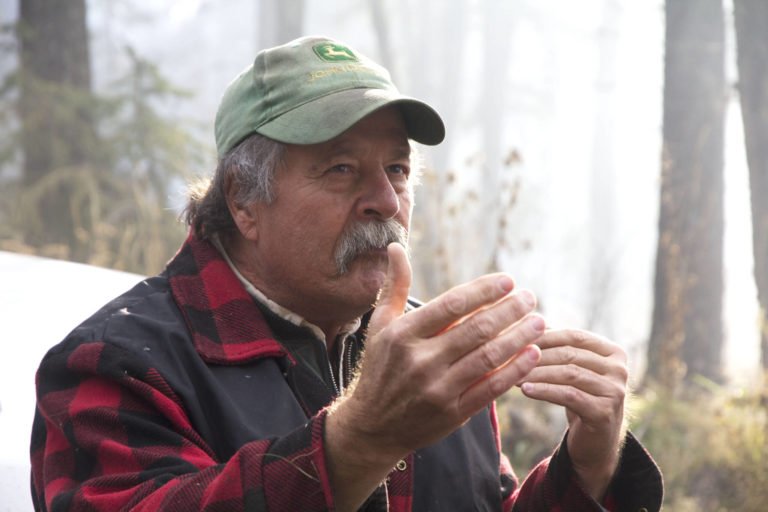Proper fuel mitigation will require a substantial investment from all levels of government
Kelly Sinoski, 100 Mile Free Press – November 12, 2021
The public will have to change their mindset around burning and logging in their “backyard” forests to prevent wildfires in the future, according to the 100 Mile District land manager.
Pat Byrne, 100 Mile district manager for B.C. Ministry of Forests, Lands, Natural Resources Operations and Rural Development, said wildfire suppression and outdated forestry management practices over the past 150 years have made local forests “unnatural,” increasing the risk of interface fires with excessive fuel on the ground and thickly wooded canopies resulting in hot, intense and prolonged fires.

In the past, Indigenous or regular burning of the landscape every 15 -20 years meant forests were more open and there was less flammable fuel, including live or dead plants on the ground, making it harder for fires to get into the tree tops.
“We’ve got to get these ecosystems back to their natural functioning conditions, we’ve taken them away from that,” Byrne told attendees on a field trip to the 100 Mile District Community Forest last Thursday, Nov. 4. “We’ve changed conditions to make it unconducive to human habitation and wildlife.”
Byrne noted the fuel mitigation treatments at the Community Forest – a 20,000-hectare swath behind Imperial Ranchettes off Horse Lake Road – is a start to “kind of bring the (forests) back.”
Over the past three years, about $1.3 million, funded by the Forest Enhancement Society of B.C. (FES), has been spent at the community forest and the 100 Mile District woodlot near the 99 Mile ski trail and railroad to remove fuels and thin trees to open up the landscape. FES was created by the province five years ago with a mandate that includes reducing wildfire risk to communities.
Byrne said the 2017 wildfires, which led to countless evacuations in the South Cariboo and cost the BC Wildfire $649 million to fight, demonstrated the need for fuel treatments in B.C. forests. “In the three or four days after the fires got ripping, we had a conversation about ‘holy crap we’ve gotta do something now,’” he said.
100 Mile District Mayor Mitch Campsall agreed “2017 woke us up and 2021 gave us another big wake-up call.”
This past summer, 263 fires burned in the Cariboo Fire Centre, covering 129,591 hectares in the region. The fires, following a prolonged heatwave, resulted in evacuation alerts and across the region. The Build-Up Index (BUI) in 2017 showed the total amount of fuel available for combustion in the Cariboo was above 90, reaching up to 200 in the Chilcotin, indicating the fuels were “dry enough to sustain a persistent, deep-burning wildfire,” according to BC Wildfire Service. The BUI was 90 and up to 160 in 2021.
Forester Dan Bedford, of DWB Consulting which is contracted to do the work in the community forest, noted the local forest around 100 Mile was not like this 50 years ago, with so much flammable fuel on the ground and tiny “ladder trees” that carry intense flames to the top of the crowns. When that happens, crews can’t fight the fires, he said. “It’s absolutely scary the amount of energy coming off it.

“These are not sticks, these are fine fuel. These are the fuels that dry out in a long hot summer and are available to burst,” Bedford said, referring to varying pieces of wood. “We get this stuff off the ground as much as possible. We put them in piles and get rid of it.”
Bedford credited the late Steve Capling, a professional forester, for setting up the treatments in the community forest and helping to pioneer a treatment where a buncher weed-eats the tiny ladder trees and bunches them, while an excavator piles the fuel in the treatment area. The idea is to space out the trees, while also making it safer for crews to get in and fight the fires.
Much of the pulp and fibre, as well as a significant portion of the residual waste fibre from the forest was taken to the Williams Lake Cogeneration Plant to be used as biomass for electricity, while other fuels are either logged or stacked to be burned.

Bedford noted there are about 2,000 piles in the area, The community forest will also require maintenance in the next 10 to 15 years, as more tiny trees grow up. He agreed there has to be a return to the old ways when “we’d have fires and fires and fires and still have forests when they were done.” If worse came to worst, he said, a backburn could now be lit in the community forest to protect local homes.
FES executive directive Steve Kozuki noted the recent situation in Logan Lake, where the Tremont Creek wildfire raged toward town, showed the importance of fuel mitigation. The town created a fuel break – spacing out crowns and removing ladder and ground fuel – to reduce the fire’s intensity. They also lit a backburn to allow the fire to creep along the ground and burn out.
Byrne said he has received “messaging” that “we can’t put all the investments in suppression efforts. We’ve got to put efforts into the prevention work. That’s why this was successful. The collaboration from all of the people here is the only thing that made it successful.”
However, Bill Hadden, Community Forest manager for the 100 Mile Development Corp., noted it will take money and political will to treat the local landscape. Although close to 400 hectares of the Community Forest was treated in the past three years, this is only 10 per cent of what should be done, and doesn’t include the local Timber Supply Area (TSA) in 100 Mile House.

“Across the 100 Mile TSA, the numbers are staggering and it’s going to take a huge commitment from senior levels of government to make it work.”
Bill Hadden, Community Forest Manager, 100 Mile Development Corp.
Byrne agreed there are “thousands and thousands of hectares” that require treatment and maintains the forest must be managed for the ecosystem – ensuring it’s resilient to pests and drought to provide habitat for wildfire – and extract the fibre from that, rather than the other way around.
“This kind of wildfire-resistant barrier has to be expanded and we have to carry that on for the rest of our forest management across the land base,” he said. “It has to be targeted at protecting those ecosystems so they can have natural function and not our version of what a pristine forest looks like.
“I hope we really run down that path hard now.”
Cariboo Regional District Chair Margo Wagner said the community forest has tremendous benefits.
“When you manage to fire smart in areas after the fires we’ve had go through in 2017, 2018 and now this past summer, it makes it more important,” she said. “The fires are scary as we all know. Any work that can be done in conjunction with the community or the municipality makes it a real bonus exercise.”
Read Kelly Sinoski’s full article in the 100 Mile Free Press, here:
https://www.100milefreepress.net/news/more-burning-needed-to-protect-forests/
For more stories on FESBC funding partners near 100 Mile House contact:
Aleece Laird, FESBC Communications Liaison | communications@fesbc.ca | 250.574.0221
